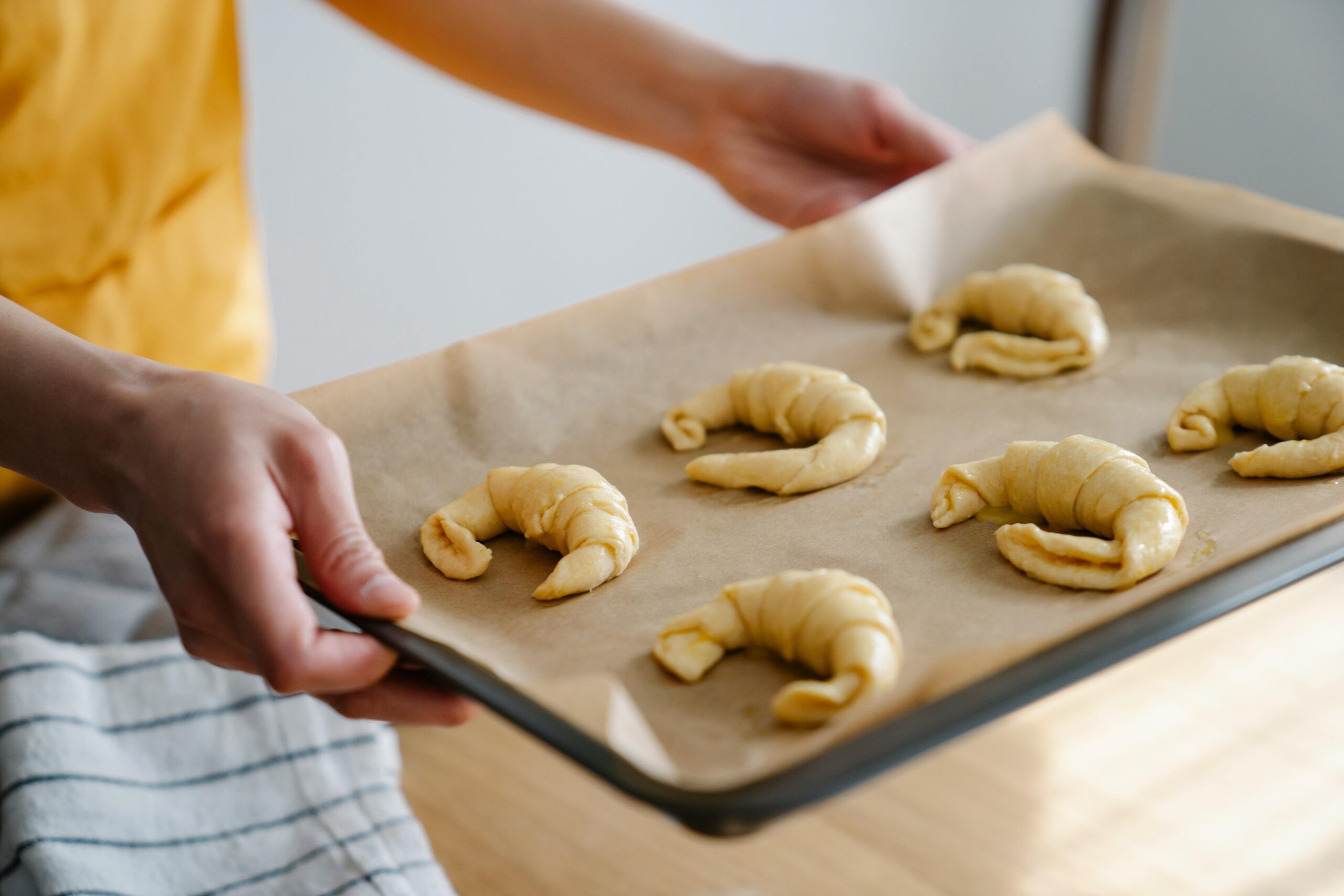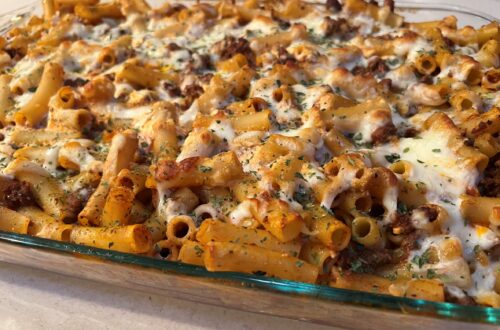In this post I hope to answer all your questions about using glass baking pans versus using metal baking pans, including how to adjust the temperature and how to choose the best bakeware for your recipe.
If I’ve missed any of your questions, be sure to leave them in the comment section below!

What is the difference between glass and metal baking pans?
Glass baking pans are made from tempered glass, which is heat-resistant and can withstand high temperatures compared to regular glass, however, it runs the risk of cracking or even shattering if used improperly (for more information on that, click here). Glass is a poor conductor of heat, so sometimes it can cause food to cook unevenly. This means that when using glass baking pans, you may need to adjust your cooking time or temperature accordingly to ensure that your food is cooked properly.
Metal baking pans, on the other hand, are made from materials like aluminum or stainless steel. These metals are good conductors of heat, which means that they heat up quickly and evenly. This can result in more evenly cooked and browned food. Metal baking pans are also typically more durable than glass baking pans and can withstand high temperatures and sudden temperature changes. However, some metal baking pans, like cast iron, can rust if not properly seasoned and maintained.
What are the pros and cons of using glass vs metal baking pans?
The pros and cons of using glass baking pans:
Pros:
- Browns the edges of dishes like casseroles without over-cooking the insides.
- Generally easy to clean and usually dish-washer safe.
- Glass baking pans are non-reactive, meaning that it will not react when used to cook things slowly or when used to cook highly acidic or alkaline foods. For more on the difference between reactive and non-reactive bakeware, click here.
- Glass bakeware is non-toxic.
- Glass bakeware is scratch-resistant and can be used with metal cooking utensils.
- The transparency of glass bakeware allows you to sneak a peek at your food as it cooks.
Cons:
- Glass bakeware is made of tempered glass so that it is able to be used at high temperatures, however, it runs the risk of cracking or even shattering if used improperly. For more information on that, click here.
- Rounded edges are not ideal for all types of baking.
- Glass is not a good conductor of heat, so food baked in glass bakeware may cook unevenly (overcooked on the outside, undercooked on the inside).
- Glass bakeware can be heavy and difficult to maneuver.
The pros and cons of using metal baking pans.
Pros:
- Metal is a great conductor of heat, so food baked in metal bakeware tends to cook evenly throughout.
- Cast iron bakeware is very durable and will last a lifetime with proper care. Cast iron also has a non-toxic non-stick coating that you develop yourself by seasoning the bakeware regularly. For more information about cast iron bakeware, click here.
- Metal bakeware that has a non-stick coating is great for baking things like cakes and cookies, which are both fragile and tend to stick to whatever they’re cooked in.
- There is a huge variety of metal bakeware to choose from, including (but not limited to) cast iron, aluminum, and stainless steel.
- Some metal bakeware, like stainless steel and aluminum, are generally light and easy to maneuver.
Cons:
- The non-stick coating on some metal bakeware can be easily damaged by metal cooking utensils, or even by cleaning in a dishwasher or a being cleaned using a rough sponge.
- Some types of metal cookware, like aluminum and copper, are reactive, meaning that it may react when used to cook things slowly or when used to cook highly acidic or alkaline foods. For more on the difference between reactive and non-reactive bakeware, click here.
- Metal bakeware that has a non-stick coating may contain fluorinated chemicals called PFAS and PFCs which are thought to be highly toxic. You may be able to reduce the risk of ingesting these chemicals by throwing away your non-stick bakeware that has any scratches.
- If not properly maintained, some metal cookware is prone to rusting.
- Cast iron needs to be seasoned and properly stored, which isn’t always great for those with a busy schedule.

How do I adjust the temperature for glass bakeware?
Please check with the manufacturer of your baking pans before putting them in the oven to make sure that they are both oven-safe, and safe at the temperature you’re planning to cook at!
Safety
Glass bakeware is made of tempered glass so that it is able to be used at high temperatures, however, it runs the risk of cracking or even shattering if used at extremely high or fluctuating temperatures.
For example, Pyrex brand glass bakeware is safe up to 425°F making it a poor choice for high-heat baking or broiling. Pyrex, and most other glass bakeware, also cannot be placed directly on heating elements like a stove top or on a grill.
If your glass bakeware is very hot and you add something cooler like broth or water, the glass may crack or shatter due to the extreme fluctuation in temperature. This is also true vice versa; if your glass bakeware is room temperature or cold and you add something extremely hot or put it in a very hot oven, the glass may crack or shatter.
How to Adjust the Temperature for Glass Bakeware
If the recipe includes the temperature and time for metal bakeware but you want to use glass, the general rule is to preheat the oven to 25°F less than the recipe asks for.
How do I adjust the temperature for metal baking pans?
Please check with the manufacturer of your baking pans before putting them in the oven to make sure that they are both oven-safe, and safe at the temperature you’re planning to cook at!
Safety
Most metal baking pans can withstand high temperatures, but it’s still crucial that you check the manufacturer’s information to see exactly what they recommend for your specific baking pans.
How to Adjust the Temperature for Glass Baking Pans
Even though metal is a better conductor than glass, it actually takes longer for things to bake in most metal baking pans. If your recipe asks for a glass baking pan but you want to use a metal one instead, consider letting your dish bake a little longer (maybe five to ten minutes).

What recipes are best for metal baking pans?
Metal is a great conductor for heat, so metal baking pans are the preferred bakeware for baked goods like cookies, cakes and brownies that need to be cooked very evenly. Quick-cooking proteins and vegetables like chicken, fish, asparagus, and bell peppers can be cooked much more quickly on a metal pan because it will heat up faster than glass. Metal pans also tend to have sharper edges rather than rounded ones, which is perfect for giving brownies those chewy edges that we all know and love.
- (most) Baked Goods (Brownies, breads, cookies, cakes, etc.)
- Sheet-Pan Dinners
- Quick-cooking Proteins (Chicken, fish, etc.)
- Quick-cooking Vegetables (Asparagus, bell pepper, tomatoes, etc.)
What recipes are best for glass baking pans?
Glass baking pans tend to cook the outside of food faster than the inside, which can be perfect for cooking crispy-edged casseroles, potatoes, dips, and more. Glass is also non-reactive, meaning that it won’t react with highly acidic or alkaline foods, so glass baking pans are great for things like baked pastas that have acidic tomato-based sauces.
- Casseroles
- Baked Pasta Dishes
- Dips (Buffalo Chicken Wing Dip)
- Potatoes
- Roasted Vegetables
- Pies (you can see through the transparent pan to see if they’re done, and pies do well with a crispy crust)

Which type of baking pan should I use?
There are so many materials, shapes, and sizes to choose from when it comes to bakeware. Here’s a list of the types of baking pans you can buy, organized by material:
Aluminum (or aluminum alloys)
Aluminum is a highly conductive metal that is great for evenly cooking food. You’ll often find aluminum bakeware in the form of baking sheets, pans, loaf pans, and more. Aluminum baking pans are usually easily accessible, often being sold at grocery stores for generally lower prices than other bakeware. They are useful for most types of cooking, but aluminum is a reactive metal so it’s best to avoid cooking highly acidic or alkaline foods because they may pick up a metallic taste or an “off” color (for more about reactive vs nonreactive bakeware, click here).
The non-stick coating on some aluminum or aluminum alloy baking pans can be easily damaged by metal cooking utensils, or even by cleaning in a dishwasher or a being cleaned using a rough sponge. It’s important to note that this non-stick coating may contain fluorinated chemicals called PFAS and PFCs which are thought to be highly toxic, and that you may be able to reduce the risk of ingesting these chemicals by throwing away your non-stick bakeware that has any scratches, and avoid cooking things at a high heat and/or for a long time.





Cast Iron
Using cast iron is a great, non-toxic way to bake, as long as you’re up for a little extra patience and maintenance. Cast iron needs to be seasoned regularly and stored in a dry area to maintain the non-toxic non-stick coating and to prevent rust. I use a lot of Lodge brand cast iron because it’s easily accessible, and their website has a very useful section on seasoning cast iron here.
It’s important to mention that cast iron is a reactive metal, meaning that it isn’t best suited for cooking highly acidic or alkaline foods (for more about reactive vs nonreactive bakeware, click here)
You can find cast iron for baking in a variety of different shapes and sizes, even including loaf pans, muffin pans, and big Dutch ovens. I use my 12″ diameter cast iron skillet for most of my cast iron needs, whether it’s cooking on the stove or popping it in the oven.



Copper
Copper has incredible conductivity, and may be one of the best ways to cook food evenly, but it doesn’t retain heat the same way cast iron or another metal might. It can be a little more on the pricey side and a little harder to find than aluminum, and requires a little extra maintenance too. Copper bakeware needs to be polished every six months with special cleaner to keep it from getting tarnished.
It’s not recommended to use copper for daily cooking because the amount of copper leeched into your food could be harmful. Copper is also a reactive metal so it shouldn’t be used to cook highly acidic or alkaline foods (for more about reactive vs nonreactive bakeware, click here). To bypass these issues, find copper bakeware that has a lining made of some non-reactive and non-toxic material like stainless steel.
Glass
Glass is a non-reactive, non-toxic material great for lots of different types of baking. However, it is not a good conductor of heat like metal is, so things tend to cook unevenly in glass bakeware (overcooked on the outside, undercooked on the inside). This doesn’t stop me from using my glass bakeware all the time for things like casseroles, baked pasta dishes, and more.


Stainless Steel
Stainless steel bakeware is durable, non-reactive, highly conductive, and non-toxic. You can use stainless steel bakeware for baking just about anything; there’s a reason it’s a favorite of chefs and home-cooks alike!
Keep in mind that if your bakeware is not 100% stainless steel, it may contain some alloys that are reactive. This means that you will have to avoid using it to cook highly acidic or alkaline foods (for more about reactive vs nonreactive bakeware, click here).



Reactive vs Non-Reactive Bakeware
Reactive bakeware is bakeware that is made of a material that may react with the food you’re cooking if it is either highly acidic or highly alkaline. For example, something acidic like tomato sauce may pick up a metallic flavor from being cooked in a copper saucepan, while something alkaline like egg whites might develop grey streaks when being whipped in an aluminum bowl. Here are some examples of reactive materials:
- Aluminum
- Cast iron
- Copper
Non-reactive bakeware is simply bakeware that is made of a material that will not react to the food you’re cooking in some way. Here are some examples of non-reactive materials:
- Glass
- Stainless steel
Are glass or metal baking pans better?
Whether glass baking pans or metal baking pans are better really depends on personal preference and the kind of cooking you’re doing. If I had to choose, I would go with metal because of the versatility






